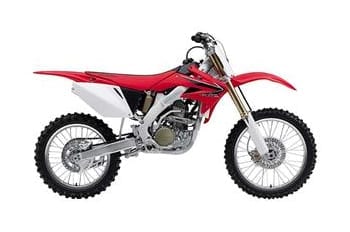Gas Gas 2008 models
By TMX Archives on 18th Oct 07

THE annual Gas Gas trials test is always one to look forward to. The sheer range of models from the Gerona-based factory, FIVE in total comprising 125-200-250-280-300, is almost bewildering and gives tester WOODY HOLE a real dilemma, as each and every model has its own virtues...
THE 2008 Gas Gas range naturally follows thewell-known PRO formula that has been fine-tuned and honed over the lastfive years. Basis of all five models is the Gas Gas-pioneered twin-sparchrom-moly steel frame which offers strength, lightness and excellentaccess to the engine unit.
And the crank-reed PRO engine unit itself is theultimate in down-scaling being the smallest and lightest on the marketwith its unique diaphragm clutch and compact, patented, six-speedgearbox allowing an ultra-slim profile.
The shapely aluminium swinging arm carries on the lightness-with-strength mantra while on the suspension front, Gas Gas pioneered aluminiumstantions, offering a considerable weight reduction over steel, whichof course the latest fully adjustable Marzocchis feature.
Wheels and running gear are the familiar tried andtested mix with a four-pot brake caliper up front and twin-pot at theback. Wheels are of the 32-spoke variety.
So, while the '08 range looks outwardly similar tothe 2007 model - it continues with the black-coated chassis which wasfirst introduced last year, replacing the previous Gas Gas trademark'shiny chrome finish - there are actually several notable changes.
The first is that there has been a subtle changein the chassis geometry. The two main frame rails are now weldedslightly lower on the headstock with the result that the engine nowsits slightly lower down and further forward which alters the weightbias. to compensate for this in the riding position the footrests aremounted several millimetres rearwards and lower.
There are also new shiny red plastics with moreshapely mudguards, a fully-enclosed front disc cover as insisted on bythe FIM and new graphics.
A new radiator, by Behr, is claimed to holdslightly more coolant and thus aid cooling while there are also claimedchanges to the gearbox and kickstart mechanism.
Now that we can all recognise an '08 Gasser it's safe to hand over to Woody to explain how they go...!
TEST
FIRST-off, the question Gas Gas riders will wantanswering is, Can you tell the difference in the handling from theclaimed' geometry change?
Well, the simple answer is Yes!' even though thechange is only minor. The change has probably come about followingcomments made by supported riders who have found the front-end goingover-light on very steep climbs and steps, very likely following theintroduction of the lightweight front forks.
Whatever, there is definitely a more front-heavyfeel as the weight bias has been shuffled forwards. I must admit thoughthat I couldn't actually tell the difference in the footpeg position.The bottom line is that the overall weight distribution, front to back,felt absolutely fine and the balance remains spot-on. Steering feelsvery neutral' on all models with no falling into corners when on fulllock nor any tendency to wash-out. If anything, and this is exactly howit should feel given the changes, the front end does feel more plantedon uphill, front-light, turns.
So that's that dealt with.
On the riding front I did the obvious thing andstarted with the 125 and worked up through the 200, 250, 280 andfinally 300. To tell the truth I think the performance from the enginesis now so good that you just don't need all these options. It is very,very difficult to choose between them, especially the 250/280/300versions and Gas Gas could actually do us all a favour and chop atleast one out probably the 280!
125
Anyway, back to the 125. The bike is available intwo versions, the PRO125 and the 125R. The latter is like a baby RagaReplica and comes with the magnesium engine cases, clutch case andswinging-arm plus several other Bling touches. It also comes with theframe finished in red and the jury is still out on this radicalchange. You either like it or you don't!
Performance is very similar to the standardblack-framed model, which is what we tested, and I have to say thatstraight out of the box I reckon that this is the best performer inclass. Competition in the 125 class is totally fierce these days andthey are all very close. The Gasser has a reputation of just being arevver and a couple of years ago this was true. But each year they havemanaged to add bottom-end without losing those awesome revs and themotor is now quite torquey. Bear in mind my 14 stone (including ridinggear!) and you can imagine how this transfers down when compared to anine-stone youth on board.
Selecting the gears in the six-speed box - commonto all models - takes a little getting used to as the throw on thegearlever is shorter than most bikes but you soon get used to it
Handling is fantastic as the bike feels just solight and coupled with lively suspension, a light clutch and sharpbrakes this is everything you could ask for.
The 125 class has drastically increased inimportance since the under 17s have been restricted to them and theYouths have been rewarded by a massive increase in useable performancefrom the eighth-litre babies.
200
This one was the surprise on the day. I havealways liked the 200 Gas Gas even though | admit in its early yearsperformance was a bit weedy. The idea of a pumped-up 125 is a good oneand for 2008 Gas Gas has got this model spot-on. The performance fromthe bottom is amazing, of all the bikes, this one is almost too sharpin its initial pick-up. It has a lot of torque and the motor is just sowilling.
Handling is exactly as for the 125, the bike feelsso light - it just has a lot more go! One big point worth making isthat this is a very untiring bike to ride. I did notice that once I gotonto the 250 and bigger bikes I was getting fatigued if I rode a longsection several times straight-off. But nip back on the 200 and I feltlike I could just carry on all day.
It would make a really good bike for an event like the Scottish.
We have actually made a strong case for 200 modelsin the past but have had to accept that there is a noticeable publicresistance to the model. Riders will try the 200, say what a great bikeit is, then buy a bigger model. Whether this is because it is not seenas a proper' trials bike I don't know. But it is a real waste of agenuinely excellent model. >>>
250
This is the base model for the range of adult'Gas Gas bikes. It is the top-selling model in the range and it's nothard to see why as it is just so easy to ride. The motor is tuned toprovide a lovely soft bottom-end which is just what you need to aidgrip and provide traction. Total beginners can learn to ride just usingthe low-end soft power alone.
There is another side though and Experts can rideon the revs that apply at the other end of the scale. It really doessing when wound-up.
Handling does appear to feel heavier' on the250/280/300 than on the two smaller models, despite the fact that theoverall weights are virtually identical, but this is simply physics todo with the reciprocating weight of piston, crank, etc.
The 250 is simply a superb all-round bike.Personally, I rode it mostly in bottom gear, using the seamless flow ofpower that provides a really long' gear. I know that the top ridersall use second and third gear, using the clutch, and for massive stepsyou do need this technique. But at club and centre level the fact is itis simply not necessary.
280/300
Time was when these two Gas Gas models had quitedifferent engine characteristics. The 280 used to be a revver and the300 more of a traditional slogger of a motor. But regarding the 2008range I must admit that I found it very difficult to split the twomodels. They both do a very similar job and both bikes are, as youwould expect, very torquey.
The 280 was nice and smooth while the 300 did feela bit more lumpy' right at the bottom. The 300 has a distinct, deeperexhaust note and when you let it loose it really does pull at your arms.
John Shirt confirmed that if you regularly ridesections with big hills or ride in lots of mud where you want all-outpower and revs to burn through for grip, then the 300 is the model foryou - end-of.
The only advice here is that you really do need totest ride both models as it is absolutely impossible to say which isthe best'. Try them and you will be drawn to the subtle difference ofone or the other.
OVERALL:
First impressions count and the 2008 Gas Gas range does look really smart in the black/ red livery.
All the models ran flawlessly with firstkick-starting and perfect, clean carburetion right through the range.There was never any need to rev any engine in order to clear it outbefore attempting a section.
All models share the same basics such as theunique clutch which is excellent in operation, offering smooth releaseand instant bite combined with a really light feel. Because of itsdesign, the clutch does rattle with the engine in neutral, on someindividual models more than others, but this is absolutely nothing toworry about and the noise disappears when under load.
All models are fitted with a dual-map ignition,which you can select with a simple handlebar-mounted switch. To behonest, this is not a big deal as it only seems to be effective whenthe engine is really singing and it offers a bit more top-end go.
2008 Gas Gas - and the choice is all yours!
Specification:
